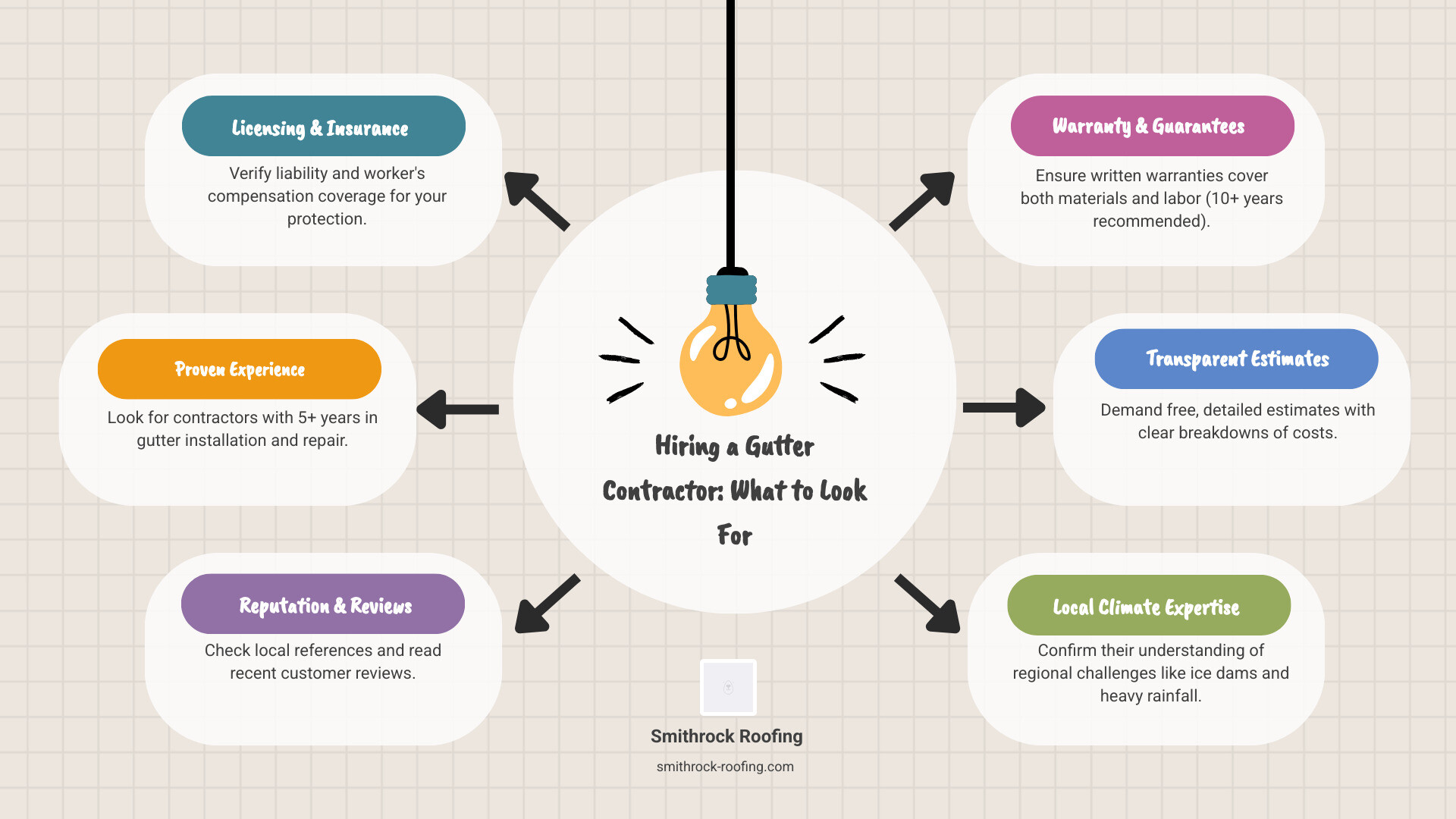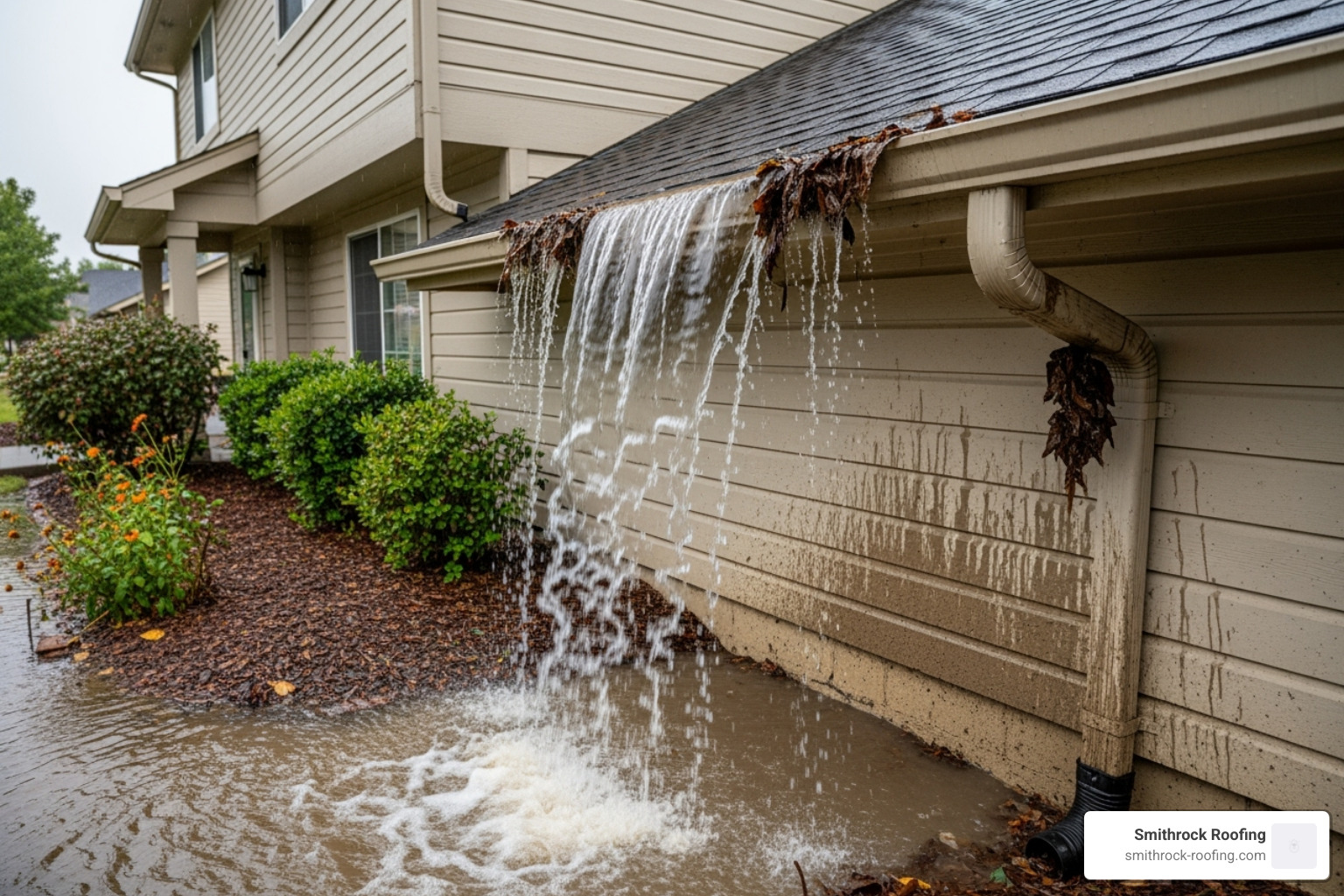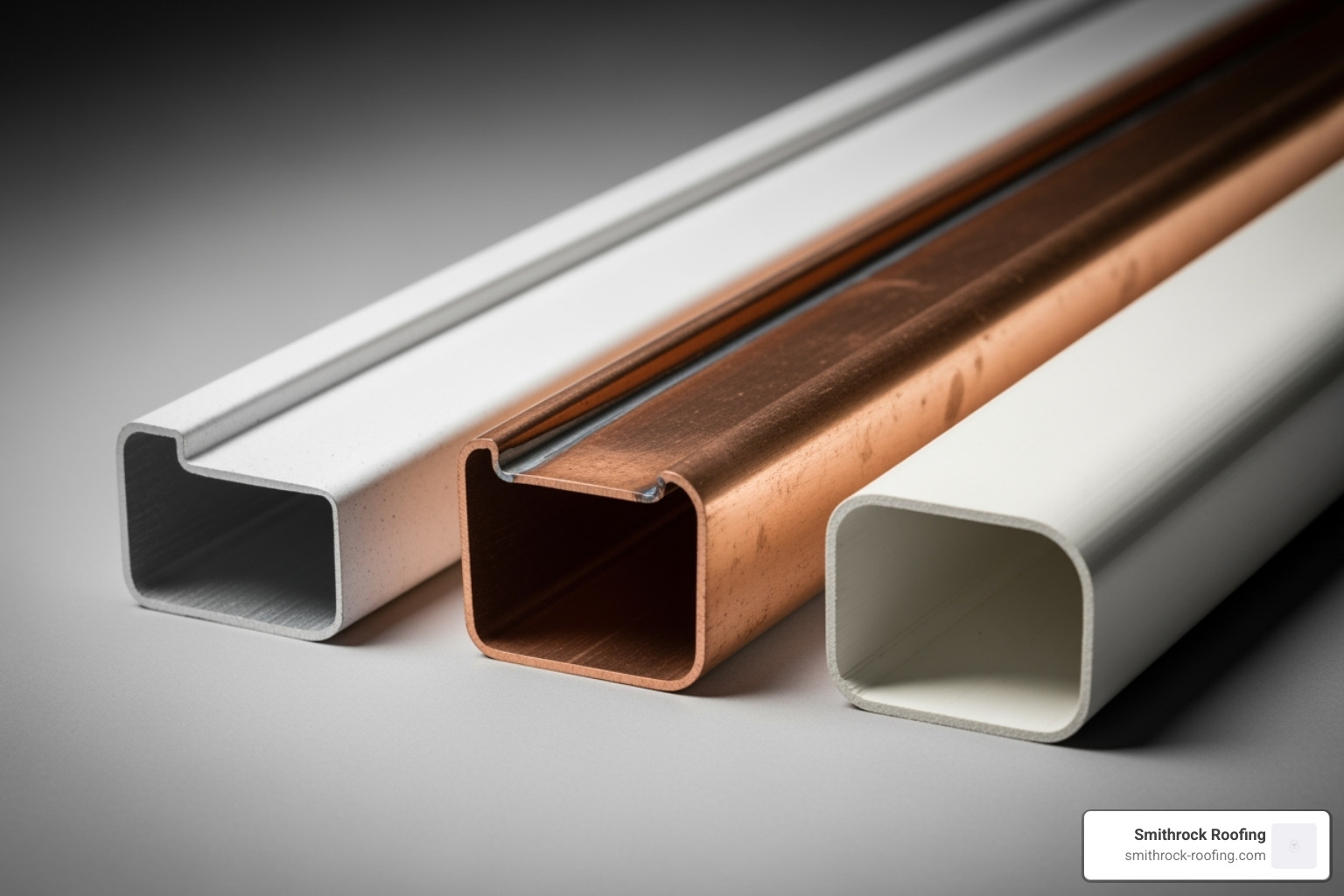Finding the right gutter installation contractor is crucial for protecting your home from costly water damage. Your gutters are a vital part of your home’s exterior, preventing everything from basement flooding and foundation issues to landscape erosion. When they fail due to poor installation or wear, the repair bills can be devastating.
When choosing a professional, look for a licensed and insured contractor with extensive experience, positive local reviews, and written warranties on materials and labor. They should also offer detailed estimates and demonstrate knowledge of local climate challenges. While the national average for professional installation is $10-20 per linear foot, this investment is a smart long-term decision that can double or triple the life of your roof drainage system.
Proper gutter installation is more complex than it appears, requiring precise slope calculations, secure mounting, and seamless integration with your roof. A small mistake can lead to water pooling or even void your roof warranty. With decades of combined experience, Smithrock Roofing helps homeowners make informed decisions, ensuring a proper installation that protects their investment for years.

Common gutter installation contractor vocab:
During a typical rainstorm, thousands of gallons of water cascade off your roof. Without a functional gutter system, that water goes straight to your foundation, landscaping, and potentially your basement. These simple channels are a non-negotiable defense for your home.

When gutters fail, the problems multiply and can lead to catastrophic damage. Water pooling around your foundation saturates the soil, creating immense hydrostatic pressure against your basement walls. This can cause soil to shift, leading to foundation cracks, settlement, and structural instability. Overflowing gutters can back water up under your shingles, leading to roof damage and rotted roof decking. This moisture can also lead to basement flooding, a homeowner’s nightmare that results in costly cleanup, ruined belongings, and potential health hazards from mold and mildew growth. Furthermore, standing water in clogged gutters creates breeding grounds for pests like mosquitoes, while the moisture-damaged wood provides an open invitation for destructive insects like termites and carpenter ants. The wooden fascia and soffit that support your gutters can rot away, requiring expensive replacement. Even your driveway and walkways can suffer from heaving and cracking due to freeze-thaw cycles in the saturated soil beneath them. Finally, uncontrolled water runoff causes significant landscape erosion, washing away topsoil, mulch, and expensive plants.
The good news? Well-maintained gutters can protect your home from these expensive headaches.
Your gutters will tell you when they need help. Be on the lookout for these warning signs that it’s time to call a gutter installation contractor:
Even if your gutters look fine, consider their age. Most systems have a lifespan of 20-25 years. Proactive replacement can prevent the expensive damage that comes with unexpected failure.
While the appeal of a DIY project is understandable, gutter installation is best left to professionals. Ladder safety is a major concern; falls are a common cause of serious injury for homeowners attempting high-altitude work without proper training and safety equipment. Professionals are trained and equipped to work safely at heights.
The technical aspects, like achieving the proper slope and pitch, are critical. A precise slope—typically about a quarter-inch drop for every 10 feet—is needed to ensure water flows smoothly to the downspouts. Too little slope causes pooling water, while too much can make water overshoot the downspouts during heavy rain. Professionals also use specialized tools, including seamless gutter machines that fabricate continuous gutters on-site. This eliminates the leaks common in sectional DIY gutters, which have multiple failure-prone seams.
Most importantly, incorrect installation can cause significant potential for roof damage, damaging fascia boards or even voiding your roof warranty. A professional gutter installation contractor ensures the job is done right, protecting your home and your investment.
More info about our Gutter Installation services can help you understand the benefits of professional installation.
Choosing the right gutters involves more than just picking a color. You’ll need to decide on materials, styles, and add-ons like gutter guards. Each choice impacts performance, longevity, and your home’s curb appeal.

Your conversation with a gutter installation contractor will start with materials, which determine lifespan and maintenance.
After choosing a material, you’ll select a profile, which affects water capacity and style.
K-style gutters are the standard for modern homes. Their flat back sits flush against the fascia, and their decorative front mimics crown molding. They generally offer superior water flow capacity compared to half-round gutters of the same width.
Half-round gutters offer a classic, traditional look perfect for heritage properties. Their smooth, curved interior helps debris flow through more easily, making them somewhat self-cleaning. However, they hold slightly less water than K-style gutters and often require specialized brackets.
The choice often comes down to matching your home’s architectural character.
“Should I get gutter guards?” is a common question. The answer is usually yes. Gutter guards provide clog prevention, dramatically reducing the need to climb ladders for cleaning. However, not all guards are created equal.
It’s crucial to understand the installation method. Some companies install guards by sliding them under your shingles, which can void your roof warranty. A reputable gutter installation contractor will use methods that don’t disturb your roofing materials. At Smithrock Roofing, our installation methods provide secure gutter guard attachment without compromising your valuable roof warranty. The investment in quality guards pays for itself through reduced maintenance and the peace of mind that your gutters are always working.
Explore our comprehensive gutter solutions to learn more about our warranty-safe protection systems.
Choosing the right gutter installation contractor is like hiring a doctor for your home—you need someone experienced and trustworthy. With some upfront homework, you can find a professional who will deliver a quality installation.

Start by getting at least three detailed, written estimates. Don’t just look at the price; a rock-bottom bid often means cut corners. A thorough proposal is a sign of a professional operation. Use online reviews and resources like the Better Business Bureau to find accredited local contractors. Ask for recent, callable references to verify their work quality. A good contractor will educate you on your options, not rush you into a decision. How to Be Happy with Your Contractor begins with making the right choice.
Experience is critical. A seasoned gutter installation contractor has tackled countless challenges and refined their techniques. Look for specific local experience; a contractor who understands your area’s climate can recommend solutions custom to handle local heavy rains or ice dam risks. Ask to see a portfolio of recent work and ensure they have specialized skills for the materials you’re considering, like seamless aluminum or copper. Our team at Smithrock Roofing serves communities like Winston-Salem NC and King NC, bringing local expertise to every job. Learn more About Us and our commitment to quality.
To properly vet a contractor, ask specific questions that reveal their professionalism and expertise:
This step is non-negotiable. Your contractor must have both liability insurance and worker’s compensation. General liability protects your property from damage caused by the contractor’s work. Worker’s compensation covers their employees if they are injured on your property, protecting you from being held liable for medical bills. Ask to see current certificates of insurance and even call the insurance provider to verify the policies are active. Also, verify any local licensing requirements and look for industry accreditations or certified installer status, which indicate a commitment to professional standards and can be crucial for product warranties.
This is a critical question. Improper gutter installation, especially for gutter guards, can void your roof warranty. The issue often arises from installation methods that involve lifting or sliding materials under your shingles. This shingle interaction can break the roof’s watertight seal. Always ask a prospective gutter installation contractor about their methods and get their contractor’s policy on warranty preservation in writing. At Smithrock Roofing, our methods are specifically designed to protect your existing roof warranty.
A contractor who stands behind their work offers comprehensive warranties. You should look for two types: a material warranty covering defects in the gutters themselves, and a labor warranty covering the quality of the installation. A strong labor warranty (10+ years) shows confidence in their workmanship. If you’re getting gutter guards, ask about clog-free guarantees. Also, check if warranties are transferable to a new owner, which can add value to your home. Our commitment to a solid Warranty reflects our dedication to every installation.
Look for a contractor who offers a full range of services, as it indicates deep expertise. This includes gutter repair, gutter cleaning, and gutter guard installation. The ability to perform soffit and fascia repair is also valuable, as these components are often damaged alongside gutters. At Smithrock Roofing, our expertise extends to roofing, windows, and siding, giving us a holistic understanding of how your home’s exterior systems work together to protect your investment.
Understanding the investment and process helps you budget and plan for your project. While the national average for professional gutter installation is $10-20 per linear foot, your final cost will depend on factors like material choice, home size, and roofline complexity.
Labor costs cover removal of old gutters, fascia preparation, fabrication, and installation, while material costs vary significantly between budget-friendly vinyl and premium copper. The good news is that the project timeline for most homes is just a single day. While a guide to gutter installation costs can offer general numbers, a custom estimate is essential. If needed, explore our Finance Options to make the project more manageable.
Our process begins with a comprehensive home assessment. A professional will visit to inspect your existing system, examine the fascia and soffit, measure your roof pitch, and calculate the required linear footage. We then perform downspout placement planning to ensure water is channeled effectively away from your foundation. After a material and style consultation, you’ll receive a detailed written estimate with a full breakdown of costs. We believe in transparency, so there are no hidden fees.
On installation day, our gutter installation contractor team works efficiently and carefully. The process includes:
A local gutter installation contractor must understand regional weather. Here in North Carolina, we design systems to handle heavy rainfall with adequate capacity and strategic downspout placement. For the occasional heavy snowfall and ice dam formation, we ensure the system is robust. We can also discuss solutions like heated gutter systems to prevent ice buildup. Our proper drainage solutions ensure water is directed far from your foundation, protecting your home from the specific challenges of our climate in areas like Winston-Salem, King, and Clemmons.
As an experienced gutter installation contractor, we hear many of the same questions from homeowners. Here are straightforward answers to the most common ones.
For an average-sized home (1,500-2,500 sq. ft.) with a standard roofline, our team can typically complete a full gutter installation in a single day. Factors that can extend this timeline include the home’s size and height, the complexity of the roofline (many corners or dormers), the need for fascia board repairs, and poor weather conditions. We will provide a realistic timeline for your specific project during our initial consultation.
In most cases, no permit is required for standard gutter replacement, as it’s considered routine maintenance. However, there are exceptions. A permit may be necessary if the project involves significant structural changes to your roof or fascia. Additionally, homes located in historic districts often have strict guidelines that require approval for any exterior modifications. Local ordinances can also vary between towns like Winston-Salem, King, or Clemmons. As your professional gutter installation contractor, we are knowledgeable about local codes and will advise you if a permit is needed for your project.
We recommend cleaning your gutters at least twice a year: once in the late spring to clear out winter debris and pollen, and again in the late fall after leaves have fallen to prevent winter clogs and ice dams. If your property has many overhanging trees, especially pines, you may need to clean them more frequently. An obvious sign that cleaning is needed is when you see water overflowing during rain. Investing in quality gutter guards can significantly reduce or even eliminate the need for this chore, turning a semi-annual task into an occasional inspection.
The correct gutter size depends on your roof’s surface area, its pitch, and the maximum rainfall intensity in your region. For most homes in areas with moderate rainfall, standard 5-inch K-style gutters are sufficient. However, for homes with large or steep roofs, or in areas prone to torrential downpours, upgrading to wider 6-inch gutters is a wise investment. Six-inch gutters can handle nearly 40% more water than 5-inch gutters, providing superior protection against overflow. A professional contractor will perform the necessary calculations to recommend the right size for your home.
Sectional gutters are the type sold in 10-foot lengths at home improvement stores. They are joined together in sections, creating multiple seams along the length of the gutter run. Each seam is a potential weak point that can leak or separate over time. Seamless gutters, by contrast, are custom-fabricated on-site by a gutter installation contractor using a specialized machine. Each run is a single, continuous piece of metal, with seams only at the corners. This drastically reduces the potential for leaks and creates a stronger, more durable, and more attractive system.
Whether to repair or replace depends on the age and condition of your current system. Minor issues, like a single leaky seam or a loose bracket on an otherwise healthy system, can often be repaired cost-effectively. However, if your gutters have widespread problems like extensive rust, multiple cracks, sagging along long sections, or are more than 20 years old, replacement is usually the smarter long-term solution. The cost of repeated, piecemeal repairs can quickly add up to more than the price of a new, reliable system that comes with a warranty.
Your gutters are your home’s first line of defense against the costly and destructive power of water damage. From protecting your foundation to preventing roof rot, a properly functioning gutter system is not a luxury—it’s a necessity. The importance of professional installation by a qualified gutter installation contractor cannot be overstated. The precision required for slope, mounting, and sealing is a job best left to experienced experts to avoid risks like roof damage or voided warranties.
The long-term value of a professionally installed system is clear. It improves curb appeal, protects your landscaping, and provides decades of reliable performance. When choosing a contractor, remember to prioritize experience, local knowledge, and proper insurance. Ask about how they will protect your roof warranty—a crucial question that can save you from future headaches.
At Smithrock Roofing, we understand that protecting your investment requires a comprehensive approach. We’re not just a gutter installation contractor; we are your partners in home protection, serving Winston-Salem and surrounding North Carolina communities with a commitment to quality. The peace of mind that comes from a flawless gutter system is priceless.
Contact Us for a professional assessment of your gutter needs and let us help you secure your home for years to come.

Smithrock Roofing © Copyright 2025 • All Rights Reserved • Privacy Policy • Maintained by Mongoose Digital Marketing